Chinese Name: 李庄古镇 Pronunciation: Lǐzhuānɡ Gǔzhèn
Service Hours: 9:00-18:00
Recommended Time for Visit: 3-4 Hours
Occupied Area: 67.2 square kilometers
Address: Lizhuang Town, Cuiping District, Yibin City, Sichuan Province, China
Seniors over 60 years old are free for the admission fee of scenic area.
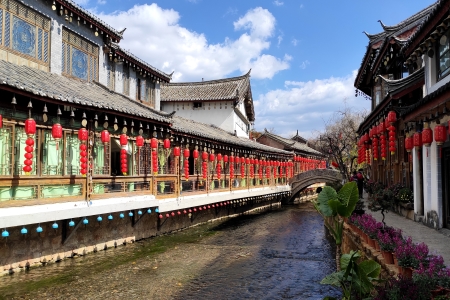
As a state-level historic ancient town in China, Lizhuang Ancient Town is located in Lizhuang Town on the south bank of the Yangtze River, 19 kilometers from Yibin City.
Lizhuang Ancient Town, known as “the first ancient town along the Yangtze River”, is one of the four cultural centers (Chongqing, Chengdu, Kunming, and Lizhuang) during the War of Resistance Against Japanese Aggression (1931-1945). The town, which adheres to the cultural backup during the war, is, therefore, acclaimed as “the reflection of Chinese culture and the cultivation of national spirit”.
With numerous ancient monuments and rich cultural attractions, Lizhuang Ancient Town is worth visiting, especially for fans of ancient China. When you are walking through the streets, the giant cluster of ancient buildings will attract your eyes. The layout of Lizhuang is quite similar to that of the Ming (1368-1644) and Qing (1636-1911) Dynasties. The streets are paved with stones, and buildings of ancient styles stand on both sides of the streets. They enjoy a rigorous layout and large scale that reflect the characteristics of the southern Sichuan dwellings, temples, courtyards, and ancestral halls hundreds of years ago.
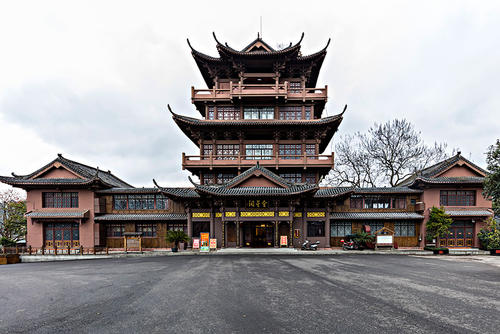
There stand many characteristic temples, halls, and ancient opera stages, such as Luoxuan Temple from the Ming Dynasty, Dongyue Temple, Zhang’s Ancestral Hall, Huiguang Temple, Jade Buddha Temple, and other ancient buildings (they are collectively called “the Nine Pavilions and Eighteen Temples”). The vivid wood and stone carving patterns upon doors and windows of the buildings are beautifully crafted, with high artistic appreciation and archaeological value as well as the local characteristics in southern Sichuan.
Lizhuang Ancient Town has been awarded as a national historical and cultural town, a national beautiful town, a national AAAA-level scenic area, a national pilot town for the construction of small towns, a pilot town for the construction of 100 towns in Sichuan Province, and the first batch of characteristic small towns in China.
In the earliest times, Lizhuang Ancient Town was once a small fishing village.
In the Han Dynasty (202 BC-220 AD), a post station was set up here.
In the Ming and Qing Dynasties, this place was a waterway and flourished for trade business, given its proximity to the Yangtze River.
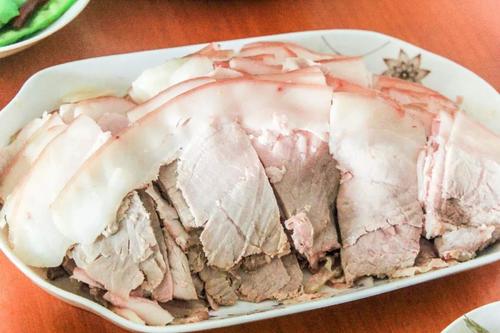
Lizhuang White Pork, one of the three famous white dishes in Lizhuang Ancient Town, is a traditional Chinese food. It is made of thin and tender slices of well-cut pork combined with a variety of sauces. The secret of cooking lies in its excellent ingredient selection and sophisticated cooking process. The dish requires the best type of pork, a good grasp of cooking time, high-standard condiments, and superb cutting skills. It is so delicious that you will not forget its taste after you taste it.
Lizhuang Ancient Town is rich in agricultural and sideline products and has a long history of food culture. Through the exploration and improvement by generations of chefs in the past dynasties, Lizhuang White Pork has become a well-known signature dish of Lizhuang.
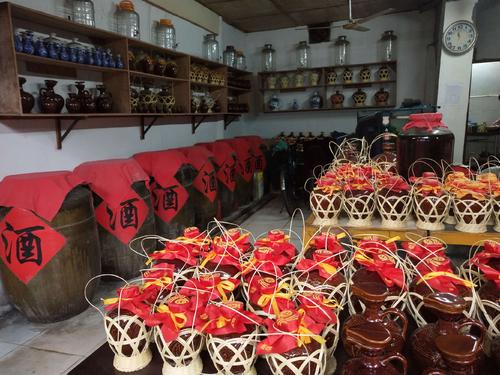
Lizhuang Liquor is made from locally produced sorghum as the main ingredient. Sorghum is first fermented and steamed by the traditional process to obtain the original liquor and then it is stored and blended for some time before being sold. This kind of liquor made from grain does not make you dizzy or drunk after drinking. It even enjoys the reputation of “Lizhuang Wuliangye” (a top brand Chinese liquor). Not only do local people like to drink it, but also many tourists often bring home lots of Lizhaung Liquor.

The main ingredient of Lizhuang White Steamed Rice Cake is high-quality glutinous rice. The first step is to fry rice, and then some Chinese herbs are added to help digesting. The next step is to grind it into fine powders, add some sugar, and then press it into shape with moulds. The finished product is sweet, soft, and glutinous. The cake is especially suitable for the elderly and children.
Located in the west of Lizhuang Ancient Town, Zhang’s Ancestral Hall covers an area of nearly 4,000 square meters. It was constructed in 1839 by the Zhang family with a capital of 660 taels of silver. The building was for expressing respect for the Zhang ancestors from its descendants and was dedicated to the ancestral hall for pursuing family roots.
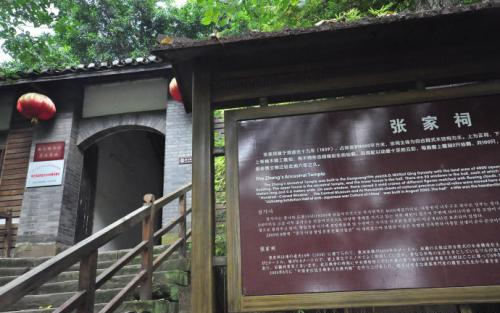
The main body of this building is a wooden structure courtyard. The most incredible is the 50 distinctive windows made of first-class Nanmu (a famous and expensive wood) of the side halls. Each of them is craved with two red-crowned cranes, 50 windows with a total of 100, in different forms, surrounded by clouds. Therefore, it was named “Hundred Cranes Windows.”
The great Chinese modern architect Liang Sicheng also admired such an exquisite art during his inspection in Lizhuang, and called the Hundred Cranes Window of Zhang’s Ancestral Hall, Xuanluo Temple, Kuixing Pavilion, and the Nine Dragons Stone Tablet of Yuwang Pavilion the “Four Wonders of Lizhuang”.
According to the records of “Zhang’s Genealogy”, each window in Zhang’s Ancestral Hall cost 14 taels of silver, which was equivalent to one month’s salary of a first-rank official in the Qing Dynasty.
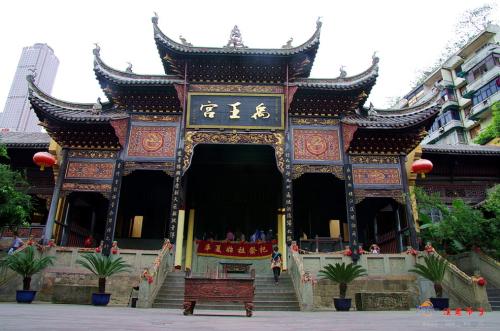
Yuwang Pavilion, now known as Huiguang Temple, was built in the 11th year(1831) of the reign of Emperor Daoguang (1821-1850) during the Qing Dynasty. The building faces north and consists of two courtyards.
In the main courtyard, there are an opera stage, a mountain gate, a main pavilion, a back pavilion, Kuixing Pavilion, wing rooms, and other buildings. The mountain gate and the opera stage are decorated with the East Asian double-eave and nine-ridge roof and Ruyi (similar to honeycomb shape) arches. The decoration gives a sense of magnificence. The opera stage inside the temple is one of the best-preserved ancient opera stages in Sichuan. On the base of the opera stage are stone sculptures carved with pictures.
Yuwang Pavilion is the largest existing building of the Qing Dynasty in Lizhuang, and its Nine Dragons Stone Tablet is familiar to all the locals.
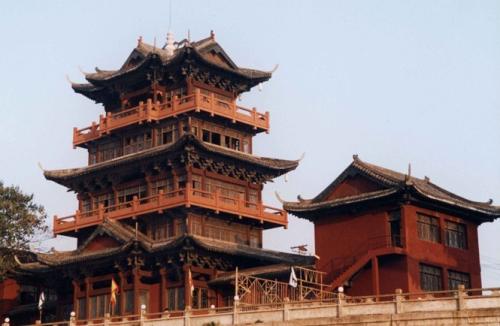
Kuixing Pavilion was built in the early years of the reign of Emperor Guangxu (1876-1908) in the Qing Dynasty. The building has three floors with the entire wooden structure. Kuixing Pavilion is situated by the river. You can see the boats sailing about 15 kilometers away in the pavilion, so it has the function of navigation. Kuixing Pavilion was once praised by the great modern architect Liang Sicheng as “the best pavilion built along the Yangtze River from Shanghai to Yibin for more than 2,000 kilometers”.
Xuanluo Temple, also known as Wenchang Palace, is located on Shiniu Mountain, 2.5 kilometers away from the south of Lizhuang. The temple was established in 1596 (the 24th year of Wanli’s reign of Emperor Shenzong of the Ming Dynasty). It is 25 meters in height, octagonal in shape, and eight meters in depth and width.
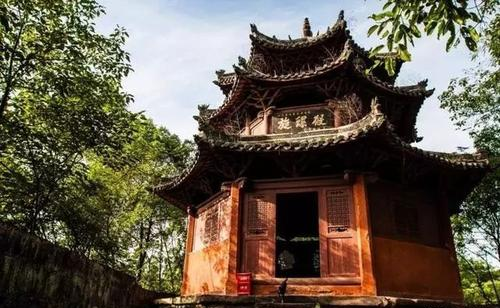
The exterior has triple eaves and the interior has two stories, with green cylindrical tiles and eight sloping ridges. Each ridge is decorated with sloping ridge animals and mythological animals. It is of great architectural art. The slope of the roof is gentle, the roof crown and the eight wings are not very high, the architecture proportion is symmetrical, and the lines are soft.
The triple eaves are of three different building styles. The formats of sloping ridges are slightly different from each other. Technically speaking, the formats are very different from those of the official ones in the Song (960-1279) and Qing Dynasties.
The internal structure design is ingeniously supported by mechanical principles without a single steel bar. Not a single nail can be found in the whole temple, but it is exceptionally solid and firm.
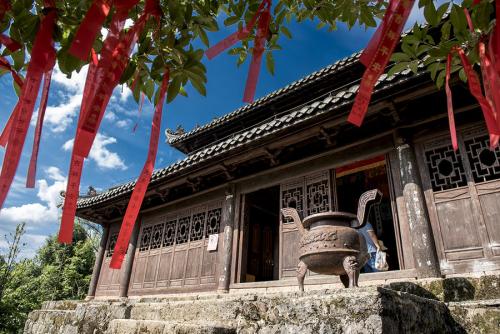
The Hall of Patriarch used to be the site of the School of Medicine of Tongji University. When walking into the deep lane, you will find a giant gate next to an old leafy elm tree. As you keep walking inside, several ping-pong table-sized stone tables in the weeds come into your eyes. These were just for teachers and students of Tongji University to dissect corpses at that time. An old villager once climbed to the Hall of Patriarch and saw corpses right there. He was so frightened that he stumbled clumsily and rolled down the steps. Then a rumor spread that the Tongji teachers and students ate people.
In order to break the rumors, scholars resolved to hold a popular science exhibition. At that time, numerous exhibitions were held, as the entire Academia Sinica and the National Central Museum were moved here. The exhibition brought a sensation in all directions, even making celebrities from Chongqing come to visit.

During the War of Resistance Against Japanese Aggression, Lizhuang Ancient Town was one of the cultural centers of anti-Japanese bases. In 1939, the National Tongji University, Academia Sinica, the National Central Museum, Society for the Study of Chinese Architecture, and other well-known institutions of higher learning and research successively moved from Beijing, Nanjing, Shanghai, and other places to Lizhuang Ancient Town. It was not until 1947 that they moved back to their original locations.
As a result, these institutions posed a profound impact on Lizhuang’s social, economic, and cultural development.
The region has a subtropical monsoon climate, with varying average temperatures for each season. It is common to rain in the summer while rainstorms and hailstones are rare here. In the case of temperature changes, please pay attention to bring more clothes. Also, the temperature here is typically lower than that of the city, given its remote location from the urban district.
Due to the proximity to the Yangtze River, Lizhuang boasts a variety of delicious fish here. It is a good choice to come to fishing boats on the river and taste river food while enjoying the river view.
Zhang’s Ancestral Hall → Yuwang Pavilion → Kuixing Pavilion → Xuanluo Temple → The Hall of Patriarch → Li Mountain Villa
Take bus 39, 45 in Yibin City and get off at the station of Lizhuang Youke Jiedai Zhongxin(Lizhuang Tourists Reception Center). After that, you need to walk westward about 130 meters along the Jingshanlu(Jingshan Road), turn right, walk about 220 meters along the Tongjidadao(Tongji Ave.) to the destination.
Chinese: 请带我去李庄古镇。English: Please take me to Lizhuang Ancient Town.
If you go to Lizhuang Ancient Town from Yibin Wuliangye Airport, it takes about 1.5 hours (about 125 yuan).
If you go to Lizhuang Ancient Town from Yibinbei Railway Station, it takes about 50 minutes (about 70 yuan).
If you go to Lizhuang Ancient Town from Yibin West Railway Station, it takes about 50 minutes (about 70 yuan).
